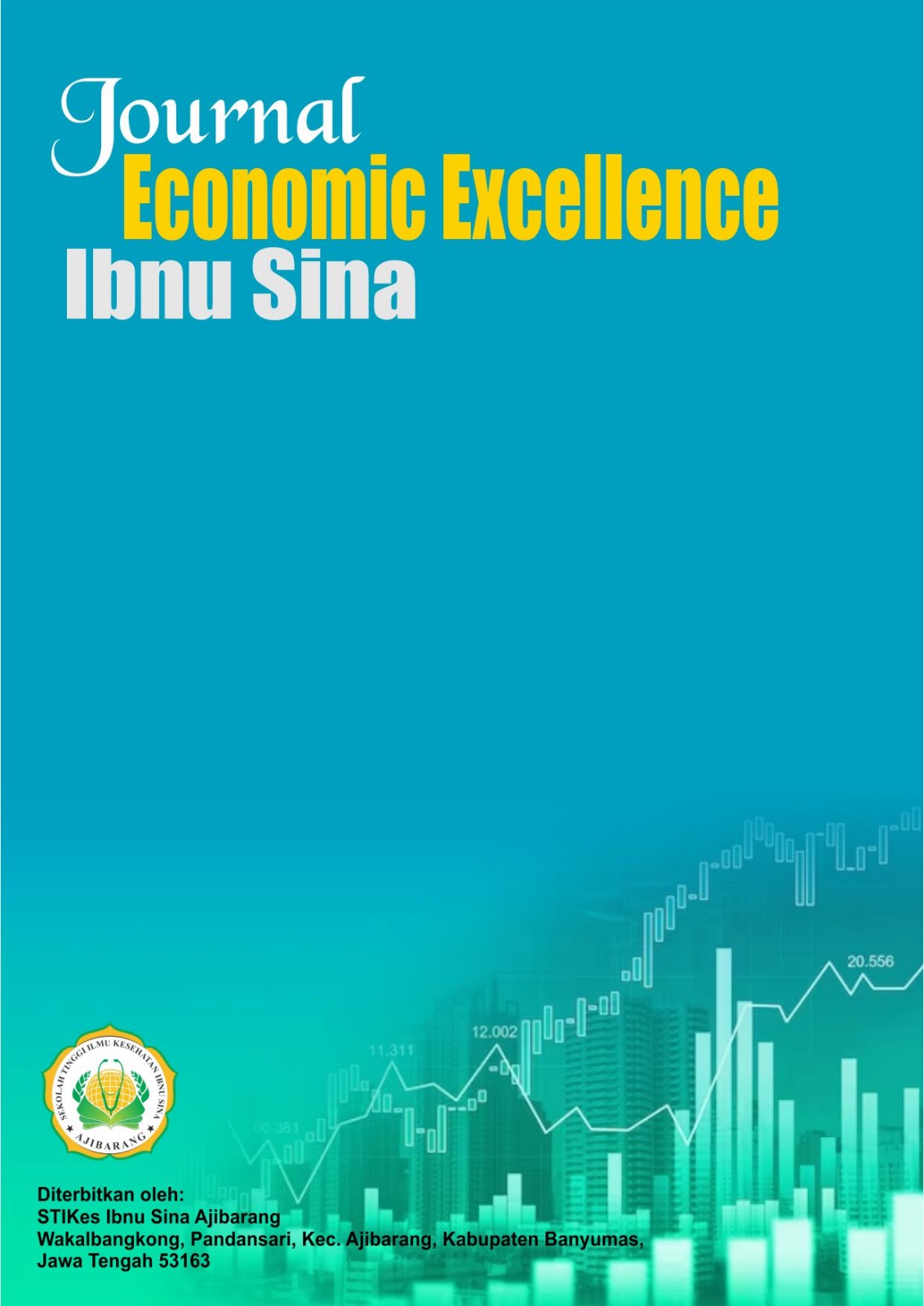The Impact of Digital Economic Dimensions on the Stability and Efficiency of Monetary Policy in Indonesia: Quantitative Analysis in the Era of Digital Transformation
DOI:
https://doi.org/10.59841/excellence.v3i1.2327Keywords:
Monetary Stability, Digital Economy, Monetary PolicyAbstract
This study uses quantitative analysis in the age of digital transformation to ascertain how Indonesia's monetary policy's stability and effectiveness are affected by digital economic characteristics. The Simultaneous Regression approach (also known as structural regression) with two simultaneous equations—monetary stability and monetary policy effectiveness—is the data analysis technique used in this study. Monetary stability (SM), the volume of digital transactions (VTD), the number of digital service users (PLD), financial technology adaptation (ATF), monetary policy effectiveness (EKM), e-commerce growth (PEC), and digital financial inclusion (IKD) are the variables considered in this study. The findings indicate that the variables VTD, PLD, ATF, and EKM have a 62.3% influence on the SM variable, with other variables outside the estimation accounting for the remaining 37.7% of SM. The estimation results show that the Effectiveness of Monetary Policy (EKM) can be explained by the Digital Financial Inclusion (IKD) and Monetary Stability (SM) variables by 11.7% and 88.3%, respectively. Aside from the estimations in the model, additional factors also affect the Effectiveness of Monetary Policy (EKM).
References
Abdillah, F. (2024). Dampak ekonomi digital terhadap pertumbuhan ekonomi di Indonesia. Benefit: Journal of Business, Economics, and Finance, 2(1), 27–35. https://doi.org/10.37985/benefit.v2i1.335
Arner, D. W., Barberis, J., & Buckley, R. P. (2017). FinTech and RegTech in a nutshell, and the future in a sandbox. SSRN Electronic Journal.
Azzahra, V., Oktopiani, L., Hanifah, F., & Darmawan, I. (2023). Dampak ekonomi digital terhadap perilaku konsumen pada era pandemi Covid-19. Madani: Jurnal Ilmiah Multidisiplin, 1(11), 316–321. https://doi.org/10.5281/zenodo.10276697
Carstens, A. (2021). Central bank digital currencies: Putting a big idea into practice. BIS Quarterly Review.
Choi, S., Willems, T., & Yoo, S. Y. (2024). Revisiting the monetary transmission mechanism through an industry-level differential approach. Journal of Monetary Economics, 145(July), 1–8. https://doi.org/10.1016/j.jmoneco.2024.103556
Economides, G., & Xepapadeas, A. (2024). Monetary policy stabilization in a new Keynesian model under climate change. Economic Theory, 56(April), 1–8. https://www.sciencedirect.com/science/article/abs/pii/S1094202524000498
Elfaki, K. E., & Ahmed, E. M. (2024). Digital technology adoption and globalization innovation implications on Asian Pacific green sustainable economic growth. Journal of Open Innovation: Technology, Market, and Complexity, 10(1), 1–34. https://doi.org/10.1016/j.joitmc.2024.100221
Gopinath, G. (2021). Digital currencies and the future of the monetary system. IMF Economic Review, 563, 563–584.
Haoran, X., Wenlong, M., & Siyu, Z. (2024). Digital technology development and systemic financial risks: Evidence from 22 countries. Borsa Istanbul Review, August. https://doi.org/10.1016/j.bir.2024.08.002
Haryanto, T., & Astuti, D. (2022). Inovasi ekonomi digital dan implikasinya terhadap kebijakan moneter di Indonesia. Jurnal Ekonomi Indonesia, 11(3), 245–259.
Ilmi, V. A., Astutik, L. B., Hasanah, W., Islam, U., Kiai, N., Achmad, H., Fakultas, S. J., Dan, E., & Islam, B. (2024). Peran bank sentral dalam menjaga stabilitas moneter. Jurnal Akuntansi Keuangan dan Bisnis, 2(1), 58–61. https://jurnal.ittc.web.id/index.php/jakbs/index
Indonesia, B. (2020). Implementasi QRIS sebagai standar pembayaran digital di Indonesia.
Indonesia, B. (2023). Laporan ekonomi dan keuangan digital 2023.
Javaid, M., Haleem, A., Singh, R. P., & Sinha, A. K. (2024). Digital economy to improve the culture of industry 4.0: A study on features, implementation, and challenges. Green Technologies and Sustainability, 2(2), 100083. https://doi.org/10.1016/j.grets.2024.100083
Kementerian Koordinasi Bidang Perekonomian. (2023). Buku Putih Strategi Nasional: Pengembangan Ekonomi Digital Indonesia 2030 (1st ed.). 1–104.
Kevin, K., Situngkir, E. S., Diana, E. S., Tenrigangka, R., Syaputri, A. R., Hartanti, D., & Kurniadi, A. (2019). Efektivitas bank sentral dalam menjaga kestabilan nilai tukar. Equity: Jurnal Ekonomi, 7(2), 1–11. https://doi.org/10.33019/equity.v7i2.4
Li, Z., Chen, S., & Chang, X. (2024). Achieving clean energy via economic stability to qualify sustainable development goals in China. Economic Analysis and Policy, 81(March), 1382–1394. https://doi.org/10.1016/j.eap.2023.11.003
Liang, Y., Wei, R., & Duan, D. (2024). Digital financial development and commercial bank stability. International Review of Economics and Finance, 97(January), 1–24. https://doi.org/10.1016/j.iref.2024.103749
Maysari, N., Pristiyono, P., & Nasution, M. F. (2023). Implementasi digital payment di lingkungan Universitas Labuhanbatu dan dampaknya pada keputusan pengguna. Magisma: Jurnal Ilmiah Ekonomi dan Bisnis, 11(2), 203–216. https://doi.org/10.35829/magisma.v11i2.327
Mishkin, F. S. (2019). The economics of money, banking, and financial markets. Pearson Education.
Mochtar, F., Sahminan, S., & Budiman, A. S. (2020). Transmisi kebijakan moneter di Indonesia menuju era ekonomi digital. Bank Indonesia, 1–311.
Mutiarazora, M. (2022). Transformasi ekonomi berbasis digital. Journal of Economics and Regional Science, 1(2), 84–96. https://doi.org/10.52421/jurnal-esensi.v1i2.189
Ohashi, K., & Shimizu, S. (2020). Monetary policy in the digital economy. Economic Policy Studies, 15(2), 123–145.
Oloyede, A. A., Faruk, N., Noma, N., Tebepah, E., & Nwaulune, A. K. (2023). Measuring the impact of the digital economy in developing countries: A systematic review and meta-analysis. Heliyon, 9(7). https://doi.org/10.1016/j.heliyon.2023.e17654
Prakosa, H. (2023). Dampak teknologi digital terhadap efektivitas kebijakan moneter bank sentral. Jurnal Keuangan dan Perbankan, 29(1), 45–62.
Renzhi, N., & Beirne, J. (2023). Corporate market power and monetary policy transmission in Asia. Pacific Basin Finance Journal, 82(December), 1–30. https://doi.org/10.1016/j.pacfin.2023.102132
Riyana, D. I., & Mala, I. K. (2024). Peran ekonomi digital terhadap kinerja pasar modern di Indonesia. Jurnal Kebijakan Bisnis dan Manajemen, 17(1), 23–31. https://doi.org/10.31289/jkbm.v6i2.3801.2
Rose, A. K., & Rose, A. I. G. (2024). A presence of absence: The benign emergence of monetary stability. Journal of International Money and Finance, 146(August), 1–45. https://doi.org/10.1016/j.jimonfin.2024.103125
Wahyuningtyas, A. D., Sasana, H., & Sugiarti, R. R. (2019). Analysis of the influence of digital economic development on economic growth in Indonesia year 1996-2019. Directory Journal of Economic, 3(1), 269–281.
Widiastuti, E., Lestari, D., & Prasetyo, H. (2023). Ekosistem digital di Indonesia: Peluang dan tantangan. Jurnal Ekonomi Digital, 9(4), 37–50.
Widodo, T. (2023). Korelasi indikator ekonomi digital. Jurnal Riset Ekonomi, 29(1), 45–62.
Xia, L., Baghaie, S., & Mohammad Sajadi, S. (2024). The digital economy: Challenges and opportunities in the new era of technology and electronic communications. Ain Shams Engineering Journal, 15(2), 1–26. https://doi.org/10.1016/j.asej.2023.102411
Yang, Y., Lin, Z., Xu, Z., & Liu, S. (2024). The impact of digital finance on regional economic resilience. Pacific Basin Finance Journal, 85(June), 1–8. https://doi.org/10.1016/j.pacfin.2024.102353
Zhang, Q., & Zhao, X. (2024). Can the digital economy facilitate the optimization of industrial structure in resource-based cities? Structural Change and Economic Dynamics, 71(December), 405–416. https://doi.org/10.1016/j.strueco.2024.08.010
Zhang, Q., Wu, P., Li, R., & Chen, A. (2024). Digital transformation and economic growth efficiency improvement in the digital media era: Digitalization of industry or digital industrialization? International Review of Economics and Finance, 92(April), 667–677. https://doi.org/10.1016/j.iref.2024.02.010
Zhang, Z., Meng, Q., Wang, J., & Wu, Y. (2024). Digital economy, customer stability, and organizational resilience. International Journal of Production Economics, 72(February), 1–6. https://www.sciencedirect.com/science/article/abs/pii/S154461232401609X
Zheng, M., Feng, G. F., Wang, Q. J., & Chang, C. P. (2023). Financial globalization and technological innovation: International evidence. Economic Systems, 47(1), 1–9. https://doi.org/10.1016/j.ecosys.2022.101048
Downloads
Published
How to Cite
Issue
Section
License
Copyright (c) 2024 Journal Economic Excellence Ibnu Sina

This work is licensed under a Creative Commons Attribution-ShareAlike 4.0 International License.








